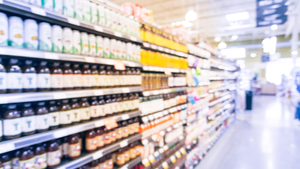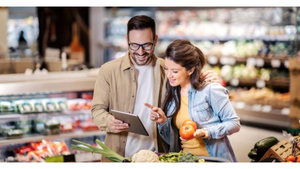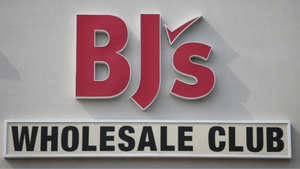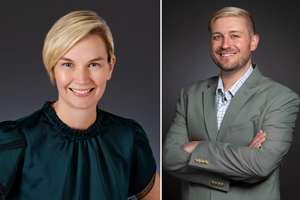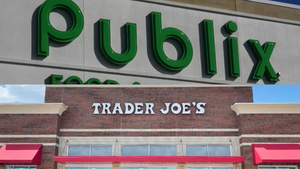Q&A: Ahold Delhaize CEO Frans Muller eyes seamless ‘customer journeys’Q&A: Ahold Delhaize CEO Frans Muller eyes seamless ‘customer journeys’
Company’s omnichannel formula builds brand loyalty and wallet share with today’s in-store, online and value-focused shoppers, the global food retail veteran said.

Frans Muller has served as president and CEO of Ahold Delhaize since July 2018. Previously, he held the role of deputy CEO and chief integration officer following the completion of the merger of Royal Ahold and Delhaize Group in July 2016. His tenure at Delhaize also includes serving as chief operating officer of Delhaize America from October 2016 to January 2018 and, before that, as president and CEO of Delhaize Group for three years. He joined Delhaize Group after more than 15 years in various leadership roles at German retailer Metro AG.
Ahold Delhaize’s retail network spanned 7,639 stores in the U.S., the Netherlands, Belgium and Central and Southeastern Europe through its fiscal 2023 third quarter. In the U.S., Zandaam, Netherlands-based Ahold Delhaize had 2,048 stores as of the quarter’s end, including the Stop & Shop, Giant Food, Giant/Martin’s, Food Lion and Hannaford chains. The company totaled net sales of €86.98 billion ($82.77 billion) for fiscal 2022, including U.S. net sales of $57.96 billion.
Winsight Grocery Business Executive Editor Russell Redman got a chance to sit down and talk with Muller this week during a tour of the Giant Riverwalk store in Philadelphia, the flagship location of Ahold Delhaize’s The Giant Company U.S. brand. Here are edited excerpts of the discussion.
WGB: A concept that Ahold Delhaize executives have spoken about are “omnichannel ecosystems” being formed in certain markets in the United States and Europe. Can you talk a bit more about that and what advantages it brings? We’re in one of these markets right now, with The Giant Company in Philadelphia, and there are Giant Food in the D.C. area and Stop & Shop in metro New York.
FRANS MULLER: We believe that, first of all, consumer behaviors are composed of various customer journeys—a convenience customer journey, an online customer journey and a full-shop customer journey. And we think that if you bring all those journeys under your favorite brand in a seamless way, in omnichannel fashion, that makes the most sense. That is comfortable, that is seamless. And that is easy, because you know the private label of those brands, you can get your loyalty programs fed from one angle, you can redeem in a way, you know the prices, you know the assortments. That is great comfort, and that is also great easiness. In the end, that will grow loyalty and lock in customers more. For us as a company, that will also create customers with a bigger share of wallet and with more loyalty, for which we work very hard.
To bring a stronger customer base who has more loyalty to your brand, that’s one thing. On the other hand, omnichannel only plays a role when you have brands where you can do that. You need strong brands, but with higher relative market shares [RMS]. Brand strength and relative market share is a very strong combination in which we believe. And then you combine that with No. 1 and No. 2 positions, the RMS in No. 1 or No. 2 positions, and for us that is the formula. On top of this is a high context of private label, a high context of digital technology and a high context of sustainability.
Those things you see in all the brands in our company. If you see our overall group strategy, then the Hannafords, the Mega Images, the Alberts and the Albert Heijns all fit under that umbrella. It’s an Ahold Delhaize philosophy with a foundation of very strong values which are important for us. That Hannaford goes a little bit different to market than Stop & Shop or Delhaize in Belgium is logical, but the fundamental elements are the same everywhere. If you would see a Delhaize presentation, a Mega Image presentation or a Stop & Shop presentation—very different markets, different maturity, different life cycles, different profitabilities—you would recognize that, “Ah, this must be an Ahold Delhaize company in the way they talk about their brands.” That’s a little bit of our credo.
Ahold Delhaize CEO Frans Muller (left) with The Giant Company President John Ruane at Giant's Riverwalk flagship store in Philadelphia. / Photo by Russell Redman
In-store and online shopping together
WGB: With omnichannel, it seems to have come full circle in some ways. At one point, when online shopping started to take off, it was like retailers had to scale back on stores, or even stores might be going away. But now, as we’ve all seen, stores are probably are more important than ever before. And even the top online player [alluding to Amazon] has acknowledged that brick-and-mortar is necessary.
MULLER: We’ve talked about this already for a long time. We were very early with online with Peapod Digital Labs and Peapod. We were very early with online with Albert Heijn, I think more than 25 years ago. So we were very early in the game. And then we had this whole hype of online and supermarkets are dead. And some people said big stores—hypermarkets—are dead. You can debate what you think about that. But we think that supermarkets and omnichannel is a very good combination—close to your customers, close to your communities, RMS brand strength, the things I mentioned before.
I think so far so good. Supermarkets are far away from that [high online market penetration in other retail sectors]. We won’t have 30% online shares in food. That’s very different for electronics stores and that’s maybe different for stores that sell textiles [apparel] and all these kinds of things. But for food, I think so far we have proven that this is the right model. In the U.S., we have 8% penetration online [for grocery retail], in the U.K. we have 14% penetration and in Holland we have 11%. So maturity cycles are different, densities are different, geographies are different, markets are different. But I think it will be around that ballpark, and it will not spike enormously.
And let’s not forget, an e-commerce online fulfillment proposition is also quite costly. So you see now that a lot of companies backing off digital investments, technology investments, fulfillment investments in times where, we are in a retail company and in our case we make 4 cents on the dollar but their companies will make much less than that. So how are you going to do that? So that’s also where they do balancing.
Sale of FreshDirect
WGB: Speaking of online, Ahold Delhaize decided to sell online grocer FreshDirect after owning it less than three years. Was it because that business just ultimately didn’t fit into the game plan going forward or with the concept of the seamless experience with the brick-and-mortar brands? Were there any technology issues, since FreshDirect already had automation?
MULLER: A number of the things you call out here as potential explanations are not valid, as we knew a number of these kinds of things before we bought the company. I can’t say, “Well, the automation didn’t fit” or whatever. That’s just not the case. We knew what the automation was, so we had our eyes wide open. That’s one thing. But in the meantime, the market changed quite dramatically from next-day delivery—it’s much more same-day and immediate [delivery]. I think the customers’ behavior is much more in that omni-channel fashion and we switched in those two or three years massively to click-and-collect from the store.
Sweating the assets of the store, working with the people in the stores for customers is super-convenient. They can create same-day [service] out of this. And the third thing is that we took the decision halfway one leg into Covid with different type of numbers as well. So if we add up all these kinds of things when we see that omnichannel is the solution in a fulfillment model which is more click-and-collect, same-day, immediate plus the help of some gig companies to fulfill that last mile, we came to the conclusion that if we have the ambition to get e-commerce profitable by 2025, then we have to make a few decisions. One decision was to close online fulfillment warehouses in Jersey City and Hanover in Maryland. And then we don’t close FreshDirect, but we sell it to Getir. So those are not easy decisions, as you can imagine.
ADUSA's automated distribution center in York, Pennsylvania, transitioned to the company's integrated self-distribution network last year. / Photo by Russell Redman
Growing market share via e-commerce and brick-and-mortar
WGB: Going back to Ahold Delhaize’s Investor Day event in 2021, the company said it aimed to grow sales by €10 billion between 2023 and 2025, with half of that coming from online sales. Where is the company in that growth projection?
MULLER: I think we will deliver on almost all the numbers. Net consumer online sales is a little bit slower, but it's mainly because bol.com [in the Netherlands] is slower. On the food side, we are very well in the ballpark.
WGB: Do you see as the online arena more of a place for taking market share versus brick-and-mortar? Does it offer more promise or potential?
MULLER: I would not phrase it like that. I would phrase it like organic and inorganic [growth]. We would like to grow with bricks-and-mortar omnichannel as we had in the past. But we think that we also can grow very fast with e-commerce, too. E-commerce is paired with media monetization income flows. There is a high correlation, so it gives you a part of the [e-commerce investment] funding as well. We still would like to grow strongly with e-commerce, strongly with bricks-and-mortar, strongly with omnichannel. Therefore, both targets are still now on our agenda.
It differs a little bit by market. Q3 year-to-date, the U.S. has more than 10% growth in e-commerce. So that is quite strong. In the Dutch market, high-single-digit e-commerce [growth]. In Central and Eastern European, from a very small base, more than double-digit, but from a very small base. So I don’t count on that. But you will see strong e-commerce growth going forward. We believe that’s where the customers go. We believe that we can make it easier by offering you that option. We think that you also get more loyal. We think omnichannel is the right way, and if we can do this more economically, so it’s less dilutive, that’s even better. And when we also can attach those media monetization flows, in correlation with e-commerce, then I think we’ve found a good economic model.
WGB: Right now, there are a couple of large mergers in the works, between Kroger and Albertsons and, more recently, Aldi and Southeastern Grocers. How open is ADUSA to brick-and-mortar acquisitions to add share and expand its geographical reach?
MULLER: I would answer this in the following way: We have $60 billion in sales on the East Coast, the No. 1 traditional grocer, and in all the DMAs, No. 1 or No. 2. And we said we would like to grow organically and inorganically. That’s unchanged. But there must also be a good fit. And the fit has to do with is it on strategy? Is it an unhealthy company? Can you integrate this? Is it close to your geographies? Geographies, you understand, from a procurement supply chain [perspective]. And, preferably, can such a company also give you capabilities? Based on that scoring list, we will look into these kind of opportunities. So, yes, we are there, and we have to see what has to come out of Kroger-Albertsons. That’s with those two companies and the FTC.
But we focus on our own destiny. There’s plenty of potential intensing up on the East Coast, there’s plenty of space, there’s plenty of smaller, family owned businesses and these kind of things that will come to the table. And we have a strong balance sheet. We have a strong company. So let’s see if we sit here in a year from now, and then maybe we will have news.
WGB: Any geographies that you're looking at for possible expansion?
MULLER: I would talk more about adjacencies. Adjacent states can be, but you won’t see us in Alaska.
I say this a little bit jokingly, but what I mean is there are a few elements in what I just mentioned as a short five criteria, which are important. One is synergies, supply chain and these kinds of things. If you can do these under an existing brand or you can integrate it into the family, you get a sixth family member [i.e. brand] at the table, that will be pretty cool. And another, it works better when it's closer to home. I use Alaska as a far-away example, but those elements are important—the integration quality and what does it bring?
Strong fresh and private-label offerings, such as at this Giant Food store in Timonium, Maryland, help ADUSA's supermarket banners boost customer loyalty. / Photo by Russell Redman
WGB: For a company of its size, in the United States, Ahold Delhaize is going to the table with five brands instead of 20, as some of the other larger [supermarket] players.
MULLER: But if there is a sixth brand coming to us where we think, “Hey, this is a good addition to the family” for the reasons I just mentioned, then why not?
WGB: Yes, I mean I think there’s also a strong case for not having too many brands.
MULLER: But, in retail, scale does matter. And I’mnot talking about scale necessarily for procurement but also scale in capabilities and scale in spreading your digital technology and e-commerce investments over a bigger top line that will help your profitability and your company’s durability. If those criteria are not met, then you have to see, OK, what kind of compromise do we want to make? But that’s where we are.
Click-and-collect rises to the top
WGB: Looking at online capabilities, you mentioned how pickup has really settled in as been the preferred online vehicle for customers.
MULLER: It’s quite amazing, because it all happened in a couple of years time.
WGB: In all of Ahold Delhaize’s quarterly calls, the company has kept reporting a bigger number of pickup sites in the U.S. Will all stores be able to offer the service?
MULLER: You don’t need all stores. If you have two Food Lions two miles apart from each other and you can also pick up at the Food Lion store, which is not necessarily your primary store, you don’t care. So then you can sweat your assets better. We have quite some colleagues in the country—other supermarket brands—that we don’t compete with. And then with your colleagues, you talk about these topics, “Hey, what can a store take in click-and-collect” and these kinds of things. We always thought the golden threshold now is 10% of your sales in-store. But, talking to a number of those colleagues who went a little bit further, we see that number is higher now. We would see that 15% is also possible. So there’s quite some opportunity still for quite some runway for click-and-collect.
WGB: On the delivery side, Ahold Delhaize’s brands have their own services and are using third-party providers for fill-in. Do you see more of the delivery coverage shifting to your own capabilities? That is, a greater percentage being provided by the brand’s own delivery service rather than a third party.
MULLER: I do not see that. In the past, we started this with $1 billion [in online grocery sales]. We now have $4.5 billion total [grocery e-commerce], and roughly $1 billion is still our company-operated delivery. So that share has gotten much smaller, but a lot of customers are still very loyal. So every brand has still some of that in-house. But I think the trend will go in the direction of pick-from-store and click-and-collect and third parties delivering when they can do it in a more economical way. But we still have our millions of delivery customers who are super-happy with us, our drivers, our trucks, and it’s more in the urban areas.
The Giant Company's Riverwalk flagship location in Philadelphia reflects Ahold Delhaize's vision of engaging in-store experiences and seamless omnichannel shopping. / Photo by Russell Redman
Shift to integrated self-distribution
WGB: During this visit with Ahold Delhaize, I was able to see the company’s distribution center in York, Pennsylvania, which has automation. I think ADUSA’s integrated distribution network is now over 85% self-managed, with just two cold facilities left to make the transition. What are the advantages of that?
MULLER: The advantages of a self-distributing network are that you have, in all cases, direct relationships with your vendors. In the past, it was through a third-party provider, C&S [Wholesale Grocers]. That’s one thing. The second thing you have, therefore, is better control of your total supply chain and your forecasting in ordering, delivery and these kinds of things. You will have an opportunity to optimize your working capital in a better way. You will have a better shelf availability, when it works as we have in mind. Of course, COVID was an enormous disruption to all these things. And we think we will gain freshness. Direct with vendors, you have a better contact that comes early into your supply chain, and it’s less dwelling time. Those elements are important for customers.
WGB: What are some changes being made in stores in terms of design or remodels to help accommodate the online volume?
MULLER: If you pick an order, you have to store that order because [customers are] not immediately there in front of our store with their car. So you need an operational area where you can store orders. And that is for your frozen, chilled and dry food. So we have to store that properly.
We adjusted close to 1,600 stores out of 2,000 with this staging area in the store. We made building adjustments to have the freezers and the chillers and these kind of things so that your order is neatly there. If you phone, “Hello, I’ll be at your store in a second,” or we see you through geo-fencing and say, “OK, we are out and we pick the groceries in the trolley, go to your car in, put them in the trunk and say thank you very much because you paid for everything already. If you have substitutes, then we also found a quite smart way to do that. Sometimes we connect to you, we phone you and say “Hey, Heinz ketchup is not there. Is it OK if we put our private label in?” If that’s OK, we do it. Substitution is an interesting topic, though, because you never have a 100% shelf availability just. But that is working very well for us.
So that’s why the adjustments to the store had to be made. Plus the adjustments to software, apps online, pick in store, all these kind of things. We also have Prism, proprietary software developed by PDL [Peapod Digital Labs, Ahold Delhaize USA’s digital and e-commerce innovation arm].
WGB: [ADUSA CEO] JJ Fleeman told me about Prism at Groceryshop.
MULLER: That software is much more efficient now and is very interesting for your media monetization, too.
Serving up value to shoppers
WGB: What’s your read on the U.S. consumer today and how you’re using personalization and rewards programs? It’s a more value-oriented consumer. So how are you doing that?
MULLER: I think that’s right. We see a more challenged consumer than before for the reasons we discussed. The consumers were very strong, but consumer confidence is going down. So we have to be very focused that you’re very precise in your offers so that your digital couponing is focused on who you are and your buying behaviors. That you’re developing strong private-label brands with price entry, too. That you are there for them when they need you in online and bricks-and-mortar. That you also take care of their health and you talk with your customers about how you can, with a challenging budget, still make affordable choices that are healthy and support you and your family to cook smart recipes for $2 a meal, for example, and these kinds of things.
All that support is now needed. That’s what we hired for. But that is not always easy. So we work very much on the private label. We’re very much on the digital and the personalization of offers that fit your circumstances. We make it very easy for people to bank their SNAP benefits. We support those on the item level but also on the checkout level. There’s all hands on deck to make it also for smaller budgets and smaller wallets in decent time.
Read more about:
Ahold DelhaizeAbout the Author
You May Also Like


